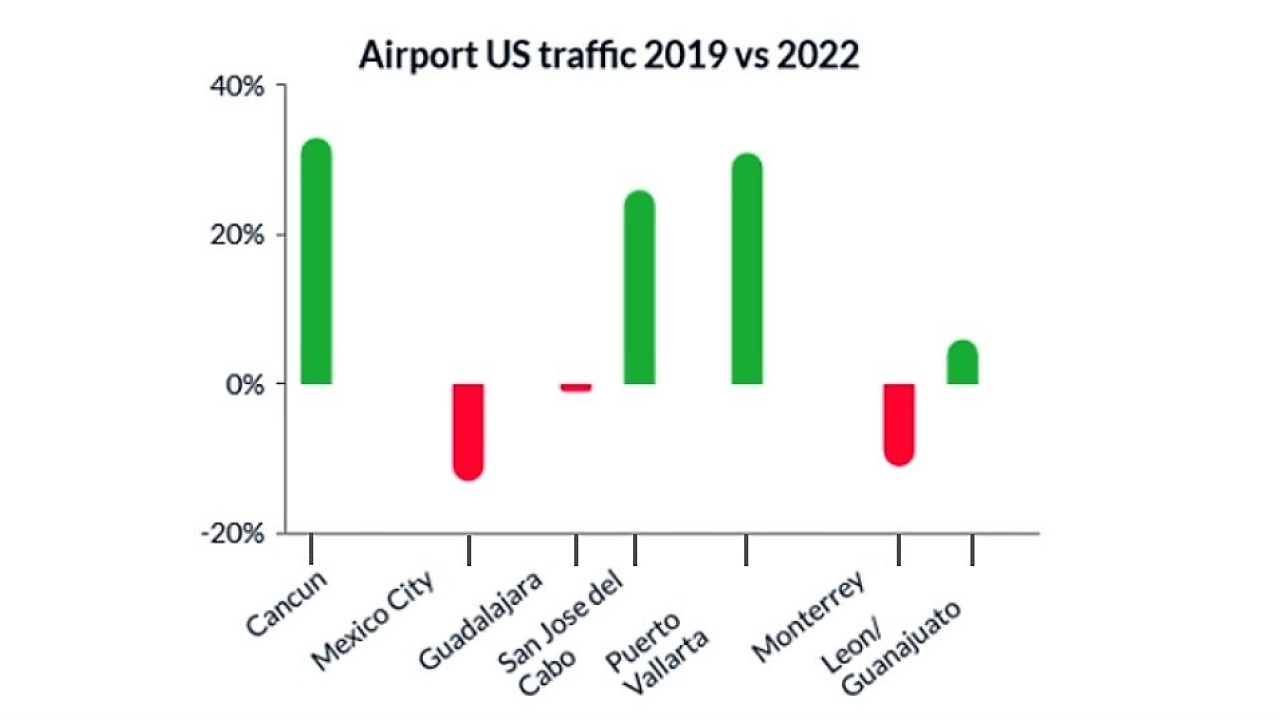Why United States-Mexico Air Traffic is on a Growth Path (Part 2)
Dion Zumbrink
May 24, 2023

© Andrew Schultz / Unsplash
Mexico was an attractive getaway for Americans during the course of the pandemic as we discovered in the first part of this analysis. Tourism has been the main driver, whereas the recovery in business centers like Mexico City and Monterrey lagged well behind in 2022, as did Guadalajara (see chart below).
Cancun reinforced its leading share in the market with an exceptional 33% growth. The destination benefited from continued strong tourism demand coming from the United States, while another upcoming location is San Jose del Cabo in the Baja California province.
Cancun, San Jose and Puerto Vallarta, combined with the business and outbound centers of Mexico City and Guadalajara, make up 86% of all air traffic to the United States from the country.
On the U.S. side, traffic is mainly generated to/from Texas where Houston, Dallas, San Antonio, and Austin have all showed major growth. In particular, hubs of American Airlines have seen an increase in Mexican capacity, a change that was evident during the pandemic.
Growth of Mexican traffic last year was strongest in Dallas/Fort Worth (at 33%), followed by Miami (up 20%), Philadelphia (50%), and Chicago (15%). Noteworthy, too, is the growth of Austin as well, which nearly tripled Mexican air traffic compared to 2019.

It is clear that coastal tourism hubs have prospered compared to cities.
© Dion Zumbrink
Key Drivers Both Ways
So, why has air travel to Mexico grown so fast, especially post-pandemic? The market has been influenced by a number of different factors coming together in the past few years.
Firstly, the relative proximity of Mexico to the U.S. has contributed to the recovery of tourism. Destinations further away, in Asia and Europe, were more difficult to reach due to COVID restrictions, while airfares have also become more expensive.
Mexico therefore offered – and still does – the best alternative to long-haul destinations over recent years. Add to this the increased remote working opportunities and Mexico quickly became a favorite destination for U.S. professionals to set up their base for a short- or long-term periods. All of this was, in part, stimulated by the government, keeping the country open at all times during the pandemic, in order to keep the tourism sector alive.
However, it has not only been the outbound market of American tourists to Mexico but vice versa, too. Interest from Mexicans to visit the U.S. for tourism and family visits is also driving up demand. This is one consequence of a well-performing economy in the last couple of years and a subsequent larger and wealthier middle class.

Cancun now has more than a third of the Mexican market to itself.
© Dion Zumbrink
The Nearshoring Trend
From a business and economic perspective, there has been a new phenomenon driving the traffic, the trend of Mexican nearshoring is contributing to air traffic growth. Companies in the U.S. with factories or business partners in, for example, Asia are looking for a closer alternative.
Less favorable production conditions in China and travel and trade restrictions, as well as the difficult political relationship between the U.S. and China have led businesses to seek alternative production opportunities in Mexico. This in turn generates more air travel demand, mainly on the business side.
American traditional carriers and ultra-low-cost carriers (ULCCs), as well as the Mexican ULCCs have picked up on this demand and significantly increased their capacity, enabling this demand to rise even further.
While in the short term the economic uncertainty and reopening of Asia may stabilize the traffic between Mexico and the United States, other trends should ensure a positive outlook. The move to nearshoring, investments in tourism, Mexican airlines expansion, and a generally favorable economic picture for the Mexican middle class offer a solid foundation for this country pair to continue growing in the medium term, and to maintain its market-leading position.
